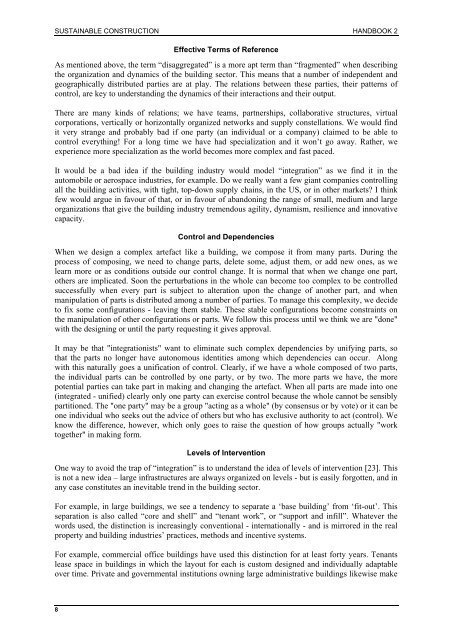Industrialised, Integrated, Intelligent sustainable Construction - I3con
Industrialised, Integrated, Intelligent sustainable Construction - I3con
Industrialised, Integrated, Intelligent sustainable Construction - I3con
You also want an ePaper? Increase the reach of your titles
YUMPU automatically turns print PDFs into web optimized ePapers that Google loves.
SUSTAINABLE CONSTRUCTION HANDBOOK 2<br />
8<br />
Effective Terms of Reference<br />
As mentioned above, the term “disaggregated” is a more apt term than “fragmented” when describing<br />
the organization and dynamics of the building sector. This means that a number of independent and<br />
geographically distributed parties are at play. The relations between these parties, their patterns of<br />
control, are key to understanding the dynamics of their interactions and their output.<br />
There are many kinds of relations; we have teams, partnerships, collaborative structures, virtual<br />
corporations, vertically or horizontally organized networks and supply constellations. We would find<br />
it very strange and probably bad if one party (an individual or a company) claimed to be able to<br />
control everything! For a long time we have had specialization and it won’t go away. Rather, we<br />
experience more specialization as the world becomes more complex and fast paced.<br />
It would be a bad idea if the building industry would model “integration” as we find it in the<br />
automobile or aerospace industries, for example. Do we really want a few giant companies controlling<br />
all the building activities, with tight, top-down supply chains, in the US, or in other markets? I think<br />
few would argue in favour of that, or in favour of abandoning the range of small, medium and large<br />
organizations that give the building industry tremendous agility, dynamism, resilience and innovative<br />
capacity.<br />
Control and Dependencies<br />
When we design a complex artefact like a building, we compose it from many parts. During the<br />
process of composing, we need to change parts, delete some, adjust them, or add new ones, as we<br />
learn more or as conditions outside our control change. It is normal that when we change one part,<br />
others are implicated. Soon the perturbations in the whole can become too complex to be controlled<br />
successfully when every part is subject to alteration upon the change of another part, and when<br />
manipulation of parts is distributed among a number of parties. To manage this complexity, we decide<br />
to fix some configurations - leaving them stable. These stable configurations become constraints on<br />
the manipulation of other configurations or parts. We follow this process until we think we are "done"<br />
with the designing or until the party requesting it gives approval.<br />
It may be that "integrationists" want to eliminate such complex dependencies by unifying parts, so<br />
that the parts no longer have autonomous identities among which dependencies can occur. Along<br />
with this naturally goes a unification of control. Clearly, if we have a whole composed of two parts,<br />
the individual parts can be controlled by one party, or by two. The more parts we have, the more<br />
potential parties can take part in making and changing the artefact. When all parts are made into one<br />
(integrated - unified) clearly only one party can exercise control because the whole cannot be sensibly<br />
partitioned. The "one party" may be a group "acting as a whole" (by consensus or by vote) or it can be<br />
one individual who seeks out the advice of others but who has exclusive authority to act (control). We<br />
know the difference, however, which only goes to raise the question of how groups actually "work<br />
together" in making form.<br />
Levels of Intervention<br />
One way to avoid the trap of “integration” is to understand the idea of levels of intervention [23]. This<br />
is not a new idea – large infrastructures are always organized on levels - but is easily forgotten, and in<br />
any case constitutes an inevitable trend in the building sector.<br />
For example, in large buildings, we see a tendency to separate a ‘base building’ from ‘fit-out’. This<br />
separation is also called “core and shell” and “tenant work”, or “support and infill”. Whatever the<br />
words used, the distinction is increasingly conventional - internationally - and is mirrored in the real<br />
property and building industries’ practices, methods and incentive systems.<br />
For example, commercial office buildings have used this distinction for at least forty years. Tenants<br />
lease space in buildings in which the layout for each is custom designed and individually adaptable<br />
over time. Private and governmental institutions owning large administrative buildings likewise make






